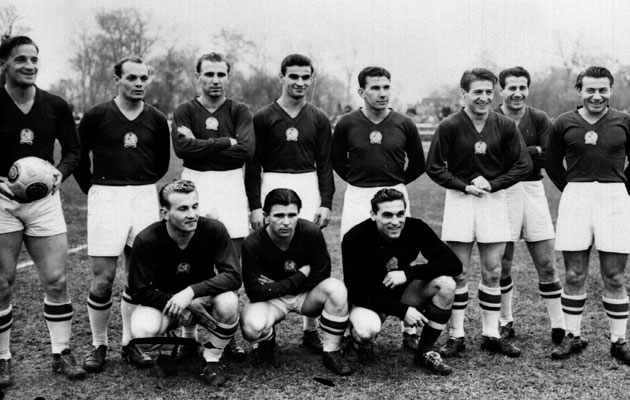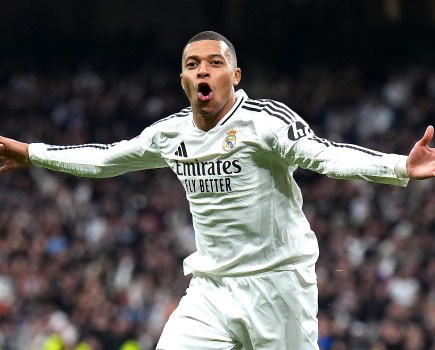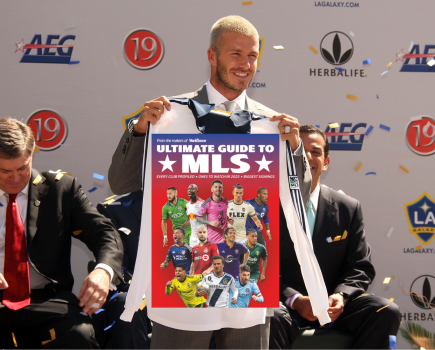In many regards the 1954 World Cup can be looked back on as the greatest ever. It was the first time that matches were shown live on television, it boasted more goals per game than any other edition in history, and it had a final that was truly memorable with a late twist in the tale.
Yet even in that tournament, a World Cup finals which saw a match between Austria and Switzerland finish 7-5 after the Swiss had led 3-0; there was one encounter which stood out. When Hungary met Uruguay in Lausanne, it was a match-up which embodied everything the World Cup was created for. The world champions took on the Olympic champions in a game which had none of the animosity that had soured some of the earliest clashes.
Going into the competition there had been little doubt about the favourites. The “Magical Magyars”, victors at the 1952 Olympics, had not lost a full international since 1950. In their 28 games without defeat the Hungarians had most notably beaten England 6-3 in 1953 (the first time England had ever lost on home territory to a team from outside the British Isles) and then annihilated the game’s inventors 7-1 in Budapest in their last game before the World Cup. These results (particularly the defeat at Wembley) finally shattered the aura of invincibility that had pervaded English football culture and announced in emphatic style the arrival of a new powerhouse.
Their captain and inspiration was the fabulous Ferenc Puskás, a short, rotund man whose stature belied his genius and who possessed a cannon of a left foot. An inside-left of remarkable gifts, he was hugely inventive but also boasted an incredible scoring record of 65 goals in 55 internationals prior to the tournament. Leading the line alongside him was Sándor Kocsis, nicknamed the “Golden Head” for his aerial prowess but who also possessed excellent ability with the ball on the floor.
The key to their victory at Wembley had been Nándor Hidegkuti, Hungary’s deep-lying centre-forward, who had bewildered the English defence with his intelligent movement. While the WM of Arsenal 20 years earlier had seen the inside-forwards withdrawn into deeper role, the Hungarians, starting at club side MTK, had chosen to follow the path of Matthias Sindelar, the Austrian star of the 1930s, in dropping their central striker into midfield. Harry Johnston, the England centre-back, had been left confused as to whether he should follow the number 9, in theory his direct opponent, or to stay put in defence. That confusion had been exploited to dazzling effect by Hidegkuti and the Hungarian forwards who profited from the space created.
At right-half was József Bozsik, a magnificent playmaker who starred for Honvéd. A childhood friend of Puskás, the pair had an almost telepathic understanding with Bozsik’s diagonal balls from the right of midfield invariably finding the clever runs of Puskás. It had taken time for many in Hungary to fully appreciate the qualities that Bozsik brought to the team given his comparative lack of pace and indifferent goalscoring record, but gradually they had realised his immense value with the metronomic abilities he offered in midfield proving vital to the success of the Aranycsapat (“golden team”).
The group stages of the tournament certainly proved eventful. A 9-0 demolition of South Korea, still recovering from an arduous voyage from the Far East, set a new record for the most goals scored in a single World Cup game. That was followed by an 8-3 win over West Germany, a result that came at a cost with Puskás suffering an ankle injury following an overly-exuberant tackle from Werner Liebrich, the German centre-half. After the event many claimed that Sepp Herberger, the West German manager, had rested players, recognising the inevitability of a Hungarian win and preparing instead for the resultant play-off with Turkey. It was a bold strategy but one which would ultimately get its reward.
Hungary’s quarter-final win over Brazil was equally momentous. Violent, even by the standards of an era in which charging goalkeepers into the net was still par for the course, it began innocently enough but descended into anarchy. It was no wonder that it came to be known as the “Battle of Berne”.
Hungary had a habit of starting games remarkably strongly and they demonstrated that yet again in the opening stages. With just four minutes played Hidegkuti crashed in a strike at the near post and the Magyars were two up after just seven minutes when Kocsis scored a trademark header across goal from Hidegkuti’s delicate centre. The teams exchanged penalties either side of half-time, Djalma Santos for Brazil and Mihály Lantos for Hungary, before Julinho displayed why he was commonly considered to be the game’s outstanding outside-right, with a fabulous strike which seemed laser-guided as it evaded the desperate attentions of Gyula Grosics.
Midway through the half, with the game increasingly being halted by niggly fouls, Bozsik and Nílton Santos, two of the game’s all-time greatest figures were dismissed for fighting. Brazil then had chances with both Didi and winger Maurinho hitting the woodwork but they would be left to rue those missed opportunities. There was still time for Humberto Tozzi to be dismissed by English referee, Arthur Ellis, for a reckless two-footed challenge on Lóránt and, reduced to nine men, Brazil’s chance was gone. Kocsis, as proficient a finisher as any in the world, settled the game in the final moments with another header after Czibor had broken away down the right. After the match all hell ensued, with the Brazilians entering the Hungarian dressing room and Puskás, who had missed the game through injury, allegedly smashing a bottle in the face of Pinheiro. Gusztáv Sebes, the Hungarian coach, found his face cut by a football boot in a series of incidents which did little for the reputation of the sport.
http://www.youtube.com/watch?v=dzl58z94WKc
Uruguay had also been well-fancied before the tournament began. Though they had finished only third at the previous year’s Copa America (Paraguay were the surprise winners) there remained a nucleus of the side that had shocked Brazil in 1950 including inside-left Juan Alberto Schiaffino and centre-half Obdulio Varela. This was the first time the Celeste had deigned to take part in a World Cup located in Europe and, given their record of winning every time they participated (both 1930 and 1950), they travelled in expectation as much as hope.
Their route to the semi-finals had been rather less tumultuous. A difficult group, including Scotland and Czechoslovakia, had been negotiated in some style, with a 7-0 win over the Scots regarded as one of the most impressive World Cup results ever witnessed. After the match Tommy Doherty, the Preston half-back, would, only half-joking, blame Scotland’s heavy kit which weighed them down in the heat of the match, but in truth it would appear unlikely to have been the deciding factor.
Their quarter-final had pitted them against British opposition again. This time it was an England side containing the likes of Billy Wright, Tom Finney and Stanley Matthews; a team who on paper looked extremely impressive despite their Hungarian humiliations. Although it proved a hard-fought contest, arguably the finest performance England delivered at the World Cup before 1966, the Uruguayans were in irresistible form. A 4-2 scoreline reflected both the calibre of the South Americans’ performance and the attacking threat that England carried.
Even before the match between Hungary and Uruguay started it was clear it would be something special. If nothing else it provided an intriguing tactical battle. So much of the success that Hungary had enjoyed over recent years had been based on the use of the deep-lying centre-forward (either Peter Palotás or Hidegkuti depending on the match) who found space in midfield thanks to the withdrawal of the centre-half into the defensive line. Although Varela, the masterful Uruguayan centre-half, was not available, his place was taken by Néstor Carballo who similarly patrolled an area of the pitch in which the Hungarians were not used to facing opponents. With both Palotás and Hidegkuti playing here in the absence of Puskás, that in turn opened up space through the middle. As they dropped deep Zoltán Czibor, himself a converted inside-left, had the opportunity to come inside and make use of the absence of a true centre-back.
Once again Hungary started quickly, bombarding Roque Máspoli’s net in the early stages. The Uruguayan keeper was forced into a sharp save from Palotás and then Bozsik, allowed to play despite his sending off against Brazil, shot wide. Their closest opening came from Hidegkuti, shooting from a narrow angle on the left, with an effort which arced just past the post in agonising fashion. Czibor was already raising his arms to celebrate as the attempt swung wide of the upright.
Hungary did still take the lead, this time requiring 12 minutes to break the deadlock through Czibor, though Máspoli should really have denied the Hungarians. It came after Hidegkuti had received the ball just inside the Uruguayan half and his lofted ball was headed on by Kocsis to Czibor, the winger’s slightly scuffed volley rolling past the despairing Máspoli and into the net. José Santamaría, who had been tracking the run of the Hungarian winger, looked on in horror as the net bulged.
The game was being played at a frantic pace with one attack after another. Uruguay saw plenty of the ball but they struggled to fashion a meaningful chance as they were frequently denied by Lantos and Lóránt, hacking the ball to safety. A constant feature was the speed of Grosics to come off his line. With the South Americans looking to play the killer ball in behind the Hungarian defence, the goalkeeper was frequently called on to sweep up. The closest the defending champions came was when Schiaffino rounded the advancing Grosics but was unable to get a clear shot on goal.
In reply the Magyars were inventive and measured in their play. The speed of Budai down the right was a regular threat while the interplay between Czibor, Hidegkuti and Palotás was intricate and precise. One man who really impressed in the Uruguayan defence was Víctor Rodríguez Andrade. His physical and technical abilities made him a constant thorn for the superb Czibor and many went away regarding him as the best right-back in the world despite the fact he nominally a right-half. The best chance the Europeans could create in the remainder of the half fell to Kocsis, unmarked about 10 yards from goal, but his powerful header had to be clawed over by Máspoli.
After the two teams returned from the interval it was Uruguay who kicked off but they quickly fell further behind when Budai, playing in place of the injured József Tóth, crossed and Hidegkuti buried the ball and himself with a wonderful diving header. Hungary looked to press their claim with a number of shots on goal that called on Máspoli to be alert. In one instance Hidegkuti was clattered in the area but no penalty was forthcoming.
Despite the absence of their natural rallying point, Varela, Uruguay demonstrated their significant experience and typical garra (fighting spirit) to prove why they had never previously lost a World Cup match. Schiaffino began to involve himself more in the game and when Javier Ambrois released Juan Hohberg, the naturalised Argentine calmly slotted the ball to Grosics’ left and drew his side back into the game.
In spite of the side’s brilliance there had always been suspicions over the Magyars’ defence. Even in humiliating England they had conceded three goals at Wembley, demonstrating a vulnerability that was there for the best sides to exploit. As such it was not a complete surprise when, with just minutes remaining, Hohberg rounded Grosics and evaded Jenő Buzansky and Lantos on the line with a shot which smashed into the roof of the net. A pulsating match now needed to be settled in extra-time.
Neither side was familiar with playing for more than 90 minutes and this would prove a test of both stamina and resolve. The Uruguayans had already demonstrated their tremendous character in rescuing the game but it looked for a second that they had found a winner in the additional period as Hohberg fired a low effort from distance which cracked against the base of the post. Schiaffino raced in for the rebound but Grosics was just able to deflect it to safety in the nick of time. Hungary were used to demolishing opponents but they too showed an ability to dig deep with the match in extra-time. In the second half of the additional 30 minutes Kocsis yet again displayed his aerial supremacy, restoring his side’s lead as he beat Santamaría to head home from a cross by Budai on the right. Minutes later he made sure with another prodigious leap, directing his header downwards from Bozsik’s centre to settle the match at 4-2.
As the media reflected on the match following the final whistle the consensus arose that this had been the greatest game in football history, for the technical accomplishment shown by the two teams as well as the excitement provided that left the spectators departing in wonder. Like many of the matches of 1954, this one would live long in the memory.
By Rob Fielder
This article originally appeared in In Bed with Maradona







